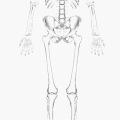This article includes a list of general references, but it lacks sufficient corresponding inline citations .(May 2015) |
| Popliteus muscle | |
|---|---|
 Popliteus muscle (shown in red) | |
Dissection video (2 min 22 s) | |
| Details | |
| Origin | Lateral femoral epicondyle |
| Insertion | Posterior surface of the tibia proximal to the soleus line |
| Artery | Popliteal artery |
| Nerve | Tibial nerve |
| Actions | Medially rotates tibia on the femur if the femur is fixed (sitting down) or laterally rotates femur on the tibia if tibia is fixed (standing up), unlocks the knee to allow flexion (bending), helps to prevent the forward dislocation of the femur while crouching |
| Identifiers | |
| Latin | musculus popliteus, poplit=ham (pit) of the knee |
| TA98 | A04.7.02.050 |
| TA2 | 2665 |
| FMA | 22590 |
| Anatomical terms of muscle | |
The popliteus muscle in the leg is used for unlocking the knees when walking, by laterally rotating the femur on the tibia during the closed chain portion of the gait cycle (one with the foot in contact with the ground). In open chain movements (when the involved limb is not in contact with the ground), the popliteus muscle medially rotates the tibia on the femur. It is also used when sitting down and standing up. It is the only muscle in the posterior (back) compartment of the lower leg that acts just on the knee and not on the ankle. The gastrocnemius muscle acts on both joints.
